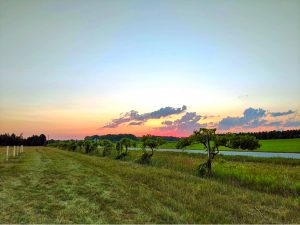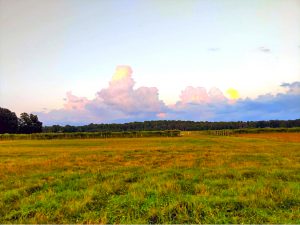
Sunset looking West
Humans are adaptable — one of our most appealing traits. We can get used to just about anything. When I was living in South Los Angeles after college, I got used to stepping over trash while I walked down the street to the bus stop; I stopped noticing the police helicopters with their spotlight eye searching my street below. The long line at the one surviving payphone in my neighborhood no longer surprised me. What did startle me was the intensity of the magenta bougainvillea growing up and over my neighbor’s fence. The dark purple silhouettes of palm trees at sunset. The kind smile of the woman across from me on the bus one morning before work.
On the Island, I’m afraid the opposite has happened to me. When I see a crumpled up beer can on the side of Jackson Harbor Road, I am appalled. But the majestic cedar growing on the corner, bold and noble, has become commonplace. While running errands, I peer around it to see if any cars are coming and turn right without noticing its incredible posture and vitality.
That is, until I was asked, by Write On Door County, to write a poem inspired by a piece of classical music, for the Midsummer Music series. I was given a CD and told to respond to the emotions of songs, without any information about the music.
The only place I have a CD player is the car, so I began listening to this piece of chamber music whenever I drove around the Island. What occurred was quite unexpected — listening to this unfamiliar piece of music unlocked the Island for me in a new way. It made me notice previously missed details and soar above the view of my rearview mirror.

Sunset looking East
I am grateful for this experience because it taught me to see the Island in a new way and appreciate the beauty I had started to take for granted. I had never really noticed the roads I was drove on— it felt like they had always been there. But while listening to the intensity of the piece of chamber music – which I later learned was Brahm’s Trio in E-flat Major, Op. 40 – I was made to consider the violence that occurred to clear land for roads. The land had to be scraped clean, smoothed out and paved, so I could navigate it easily.
Being mindful of the music made me mindful of the Island. There are many little mindfulness practices that we can do heighten our sensitivity to our surroundings. One of my favorite meditative practices is the Color Walk, where you pick a color and then go on a walk paying attention to where you see the color. Another is sitting, eyes closed, listening to the birds and insects until you start to notice a pattern. Or you can simply switch up the way you do things — instead of driving, ride a bike and notice how the landscape moves past you differently. If you have a favorite place on the Island to watch the sunset, go to the opposite corner of the Island and watch the reflection of the sunset instead. Do something new or mindful this week and share your experiences with us!
Columnist Alessandra Simmons is a poet, gardener and PhD student at UW-Milwaukee. She’s inspired by the beauty of nature every day and loves to learn about its intricacies. If you have a photo or question to share about Washington Island’s great outdoors, send it to editor@washingtonislandobserver.com.
“Everyday Nature” is sponsored by the Washington Island Art and Nature Center. The Art and Nature Center is dedicated to the promotion, preservation and understanding of the creative arts and natural history of Washington Island.
Click here for Washington Island Observer subscription info.




